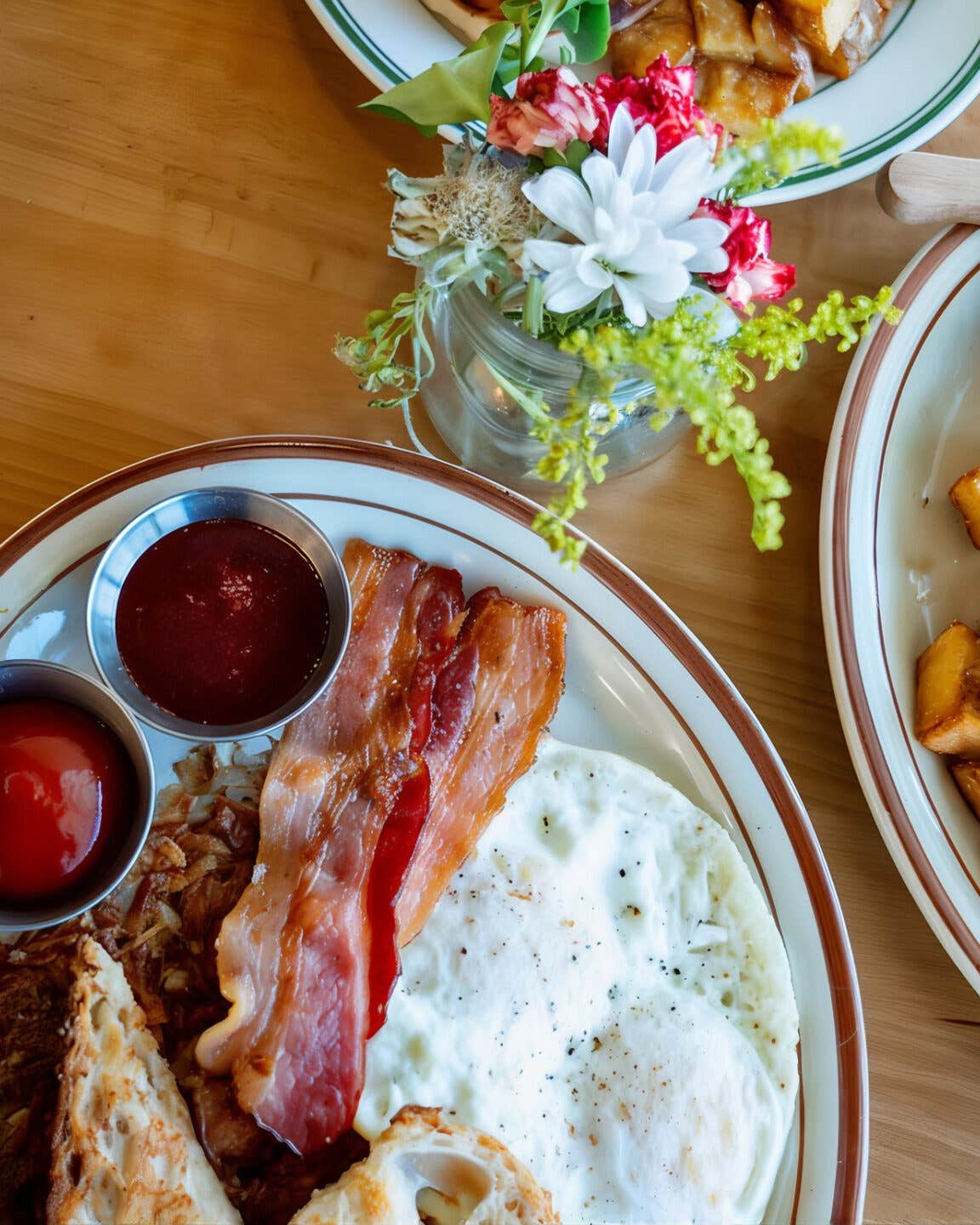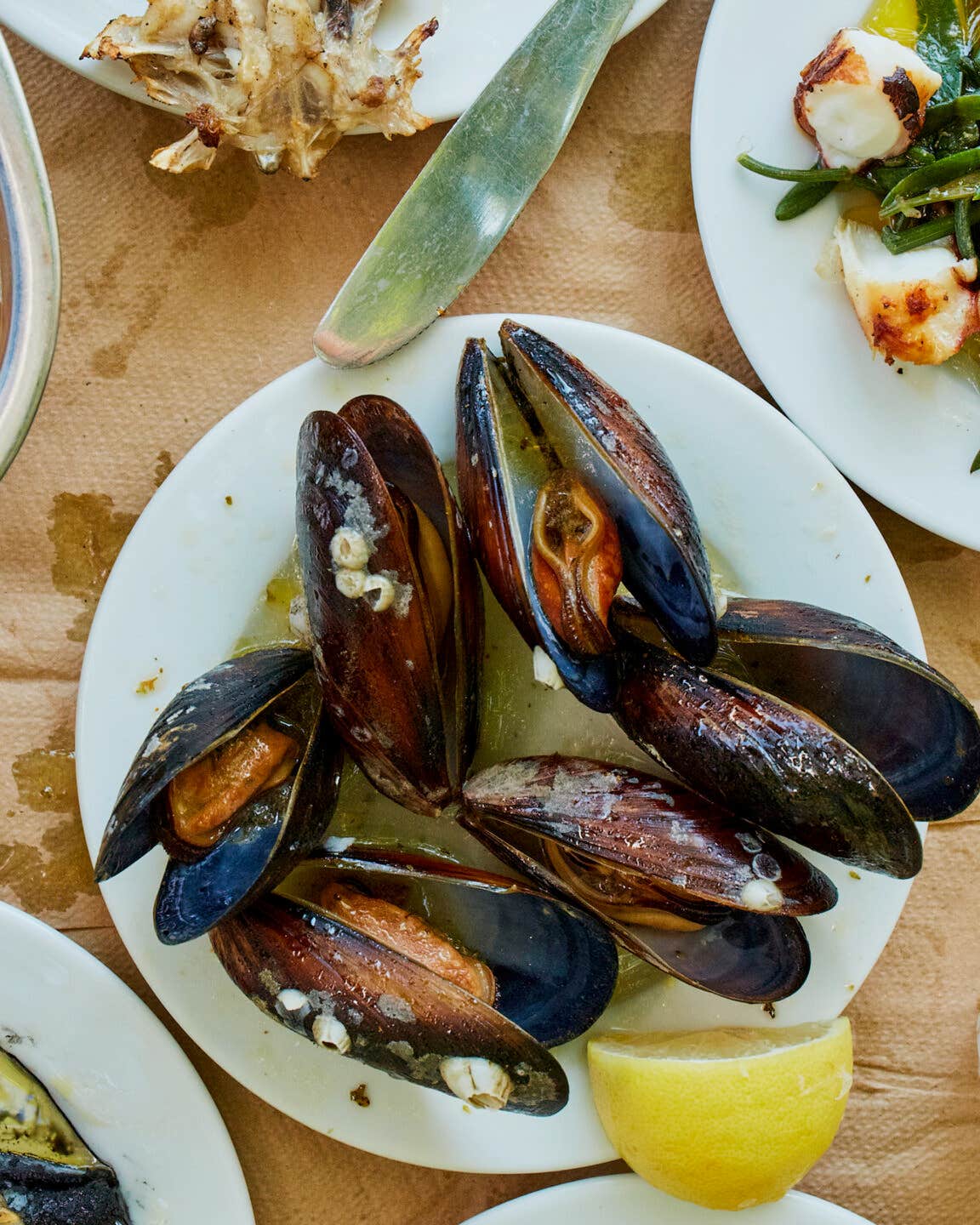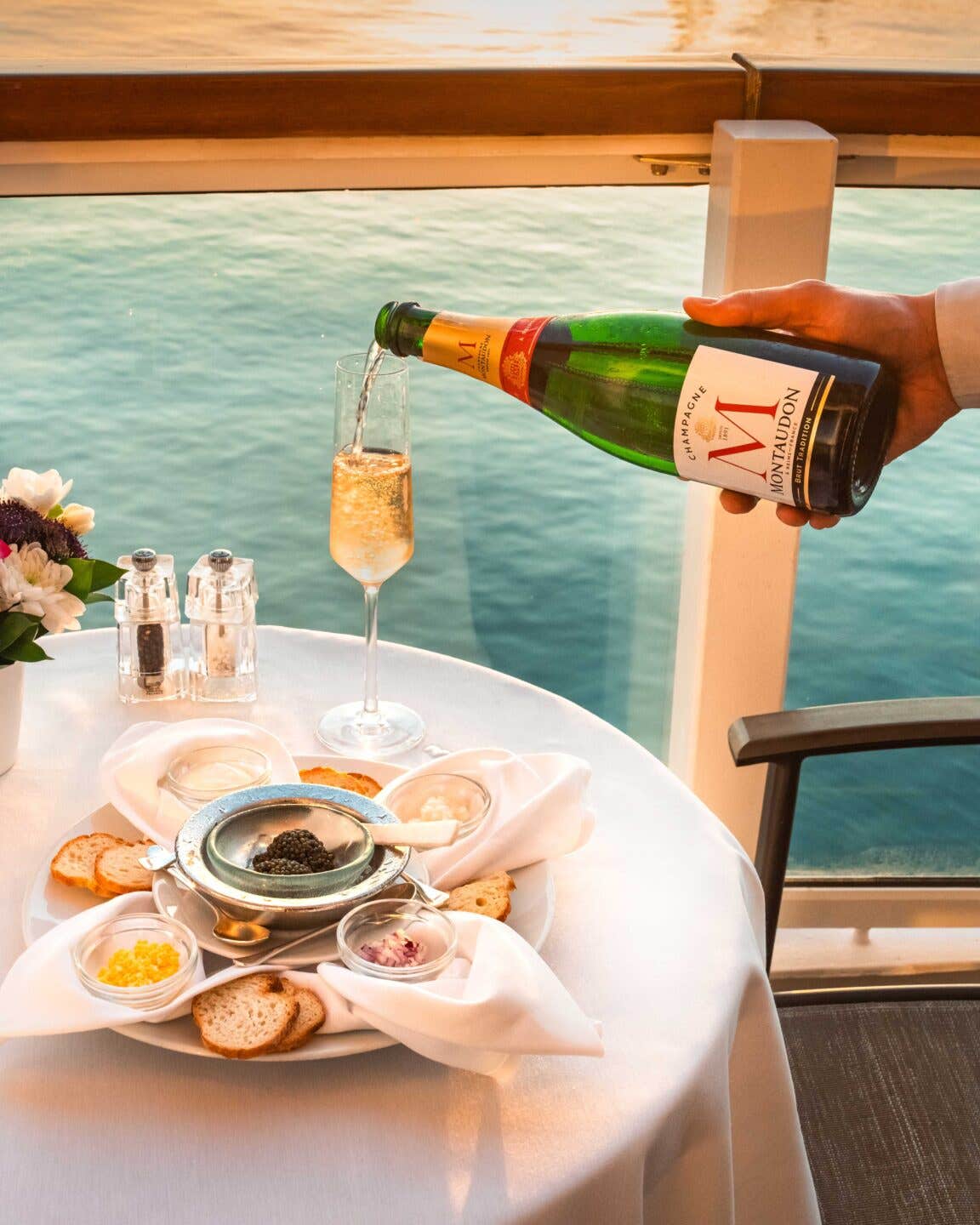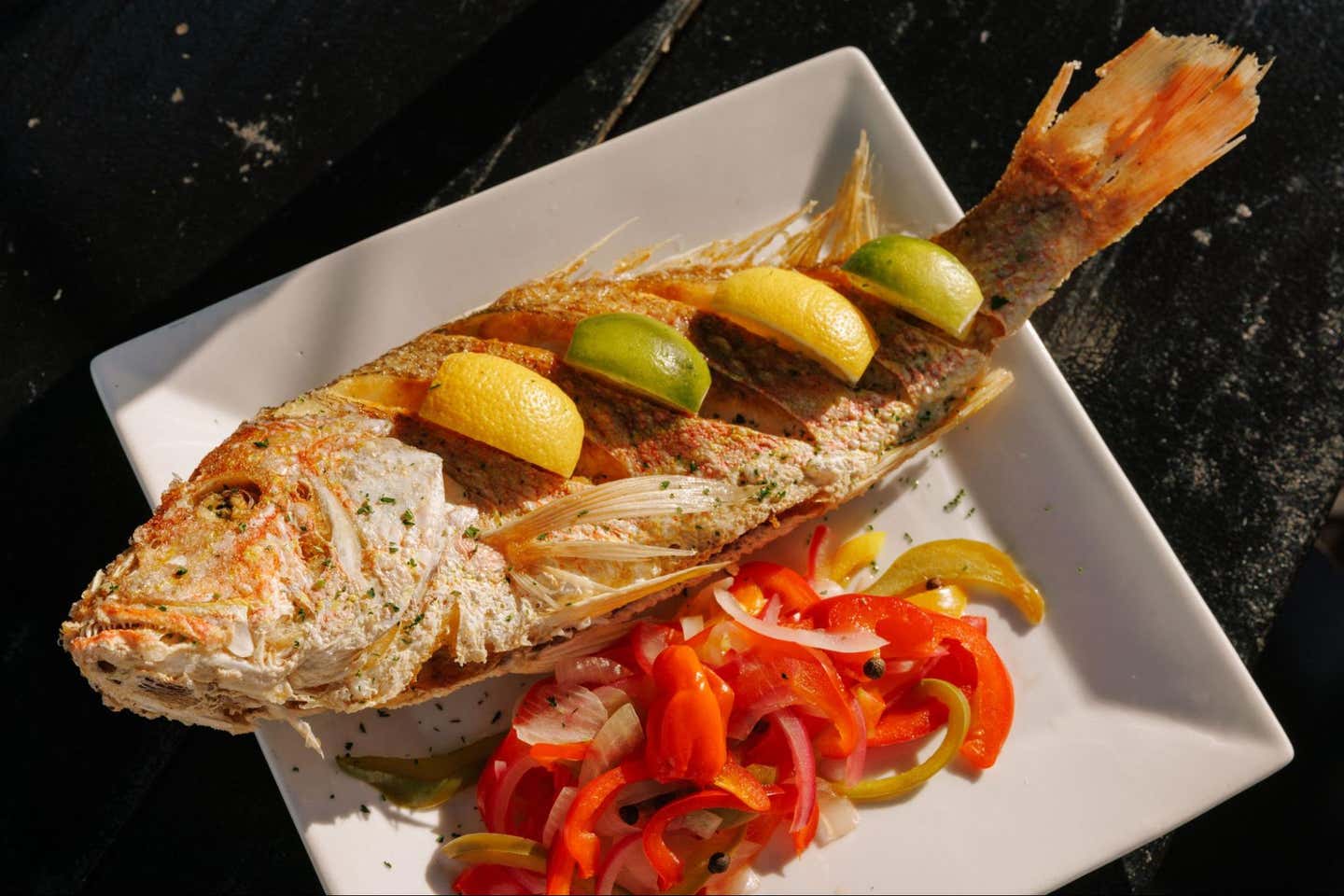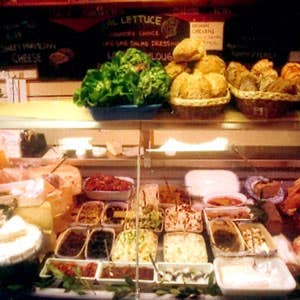
Country Comforts
It's eleven in the morning, and Country Choice—a food shop and cafe on the main street of the Irish agricultural town of Nenagh, northeast of Limerick in County Tipperary—is abustle. Housewives in sensible frocks and rain boots and smartly dressed young women with canvas tote bags and weather-burnished men in peacoats and tweed caps crowd up to the glass display case just inside the door to buy hand-sliced local ham, house-roasted barnyard chickens, organic Irish feta cheese or Baylough cheddar, luminescent lettuces grown by Ned McQuaid in his walled home garden just across the street or by Sister Gertrude in the vegetable patch outside the Convent of Mercy a few blocks away …
Farther back in the shop, past a wall of mostly non-Irish products—cans of Spanish piquillo peppers and Italian tuna, American-style caesar salad dressing, Lebanese wine—more customers occupy a handful of mismatched tables, sipping Irish breakfast tea or espresso, munching sultana scones or orange-juice-flavored oatmeal bread served from behind a small L-shaped counter. In the kitchen to the left of the counter, chef Sophie O'Dowd, with the aid of all-purpose kitchen helper Elaine Hogan, is hard at work, forming multigrain bread dough into big, rough rounds, then cutting them into thirds for baking; checking on the beef and Guinness pie and other savory dishes starting to bubble in the multilevel oven; stirring a big pot of potato and spring onion soup.
And everywhere—behind the front counter weighing hunks of cheese, by the grocery shelves helping a tiny white-haired woman pick out dried fruit for her boiled pudding, working the espresso machine as deftly as a Milanese barista, darting in and out of the kitchen to check an order, taste a sauce, josh with O'Dowd—is Peter Ward, proprietor (with his wife, Mary) of this remarkable emporium. An amiable, energetic gentleman who has been called "the greatest grocer in Ireland," Ward is the reason I've come to this Irish provincial municipality, population about 6,000—on the face of it an unlikely destination for a gastronomic pilgrimage.
I met Peter Ward in April 2002, when I was invited to participate in a specialty foods symposium sponsored by the Irish Food Board in the seaside town of Kinsale, near Cork. There was a certain predictability, the drone of officialdom, to the first few speakers in the program, and I was frankly about to repair to the bar when the tenor of the proceedings changed dramatically as the podium was taken by a man—introduced as a grocer—who, with something very much like evangelistic fire in his voice, immediately started going on about the glories of farmhouse butter and homemade brown bread and creamy Irish milk. I settled back to listen, and by the time he got to the point of saying (I paraphrase), "When people come here from another country and want to taste Irish food and we serve them something from a German-owned supermarket, that ought to be considered an act of treason!" I realized that he was somebody I should probably meet—one of those characters who espouse local specialties passionately enough to inspire food lovers far from their own locales. I introduced myself to him later in the day and asked whether I might come and visit him at his shop on my next trip to Ireland—which is how I've ended up nibbling scones in Nenagh (pronounced NEE-nah) and listening to Ward talk some more.
Ward was born, he tells me, in 1958 in the village of Dunderry, near the medieval town of Trim, west of Dublin. "My grandfather had a grocer's shop," he continues, "and I was reared on a very traditional family farm. My father was a cattle dealer who traveled all over Ireland buying stock to raise back home and to sell to other farmers, and every time he came back, he'd bring food. He had a favorite butcher shop in the west of Ireland, a favorite fish shop in the south, a cheese shop he liked somewhere. It was always a feast when he returned."
As a high-school student, Ward took a summer job with an Irish supermarket chain, then stayed with the company when autumn came. In 1979, by then experienced in the grocery trade, Ward was sent to Nenagh by his employers. He liked what he saw there. "Every morning I'd go out and buy bread and ham carved by an old man with a carving knife," he recalls. "I got to know and like the people and the town." One of the people he got to know and like was Mary D'Arcy, who was to become his wife. First, though, the chain sent Ward on to work in Dublin—"but pretty soon," he says, "I could see that the supermarket business wasn't compatible with our family's philosophy of food. I knew that there was a lot, lot better food in Ireland than was being sold in the supermarkets. I said to myself, 'I'm going to sell food—the kind I enjoy,' and I thought that Nenagh was the place to do it."
In 1982, Ward moved back to Nenagh and wed Mary D'Arcy, and the couple opened Country Choice. They were bucking a trend. "Traditional small groceries were closing all over Ireland at the time," Ward says. "They didn't have the resilience to deal with the onslaught of the chains. Some years ago, for instance, there was a supemarket price war all over Ireland over the common sliced loaf. Now, the sliced loaf would have been the mainstay of many small town bakeries, and suddenly they could no longer compete on a core product. Maybe half the bakeries in any given town eventually closed. And because they made local specialties as well as the sliced loaf, those started to disappear, too."
Nenagh was different, says Ward, because it had always been a very prosperous town, with many ties to the outside world. Nearby Lough (Lake) Derg and the Shannon River formed the main thoroughfare through the center of Ireland until the large highways were built, and Nenagh was a crossroads, a market town. Its name in Gaelic, Nenagh Urmhumhan, means "the fair of North Munster." The big Anglo-Norman farms and the monasteries in the region brought further wealth, as did the nearby mountains, called the Silvermines, a source of tin and silver since Neolithic times. "There are still big shops here trading in luxury goods," he adds, "and people have sophisticated tastes. When we opened Country Choice in 1982, the first customer who came in asked me for Earl Grey tea and camembert. You wouldn't have found that in a lot of small towns in Ireland."
After he shows me around the shop and the kitchen, Ward says, "There's a cattle market every week in Nenagh, and it's on today. Let's walk down to see it." We step out into the gray midday and turn back to look at the front of the shop. A sign in Gaelic reads Rogha na Tuaithe Tae agus Caife (Country Choice Tea and Coffee). Another boasts Bia Brea Blasta (Fine Tasting Food). Ward loves speaking Gaelic and helped found a local school to teach the language. A sign inside the shop offers Gno tri Ghaeilge? Bainimis triail as "Business in Gaelic? We'll have a go."
Turning right, we pause in front of the bright red façade of A. Ryan, once an all-purpose shop selling everything from cigarettes and candy to laundry soap and thread. Bridie Ryan, daughter of the shop's founder, lives upstairs; she closed the shop in 2002 after the death of her sister (and partner) but keeps the interior intact, still stocked with whatever was there when she closed. "I never have to go out," she jokes. "I can just walk downstairs and find anything I need." Ward tells her we're headed to the cattle market. "Oh," says Ryan, "I remember when the farmers used to walk down the street with their cows, right past the stores, in the rain, hail, or sleet. When they'd sell, they'd go to the pubs and spend their money. They brought such business to the town!"
"You have to understand the importance of cattle in Ireland," says Ward as we continue on. Then he adds with a grin, "The native Irish were like the Masai in relationship to their cows—a little more aggressive, maybe. Cattle raiding was a popular sport. Today, probably half our customers are farmers who make their living with their milk. It's literally the fat of the land."
The cattle market takes place in a big skylit shed, set up like a small arena. Bleachers curve partway around an approximately oval-shaped pen, into which assorted bovines, sometimes a single one, sometimes three or four, are herded, one lot after the other. Particulars of each beast—birth date, weight, inoculations, and so on—appear on a tote board. A rapid-fire auctioneer sells the animals, responding to cues from a crowd of 60 or 70 men—many sporting tweed hats or caps, some with walking sticks, most dressed in sober farmers' colors—that are all but imperceptible to the outsider. The scene probably hasn't changed much in centuries.
It seems fitting that our next stop is Hackett's butcher shop. Michael Hackett, a solid-looking character in the traditional ventilated white butcher's hat, buys milk-fed heifers as yearlings at the market every few months, fattens them for between three and six months on his farm outside town, then slaughters them for sale in his shop. "The oldest would be about 20 months old when killed," he says. "That's what suits me. I hang them for about two weeks, but they're so tender at that age you could almost eat them the day after they're slaughtered." As we leave, Ward says, "But the livestock business is changing, becoming more corporate and international. The small markets have maybe five years to go. Pretty soon there'll be about five big modern ones around the country instead." He shakes his head.
Back at Country Choice, we sit down for lunch. "I think I like to educate people in my shop," says Ward, as we dig into steaming bowls of Sophie O'Dowd's wonderful potato and spring onion soup, with rough-torn pieces of warm bread gilded with dense Nenagh butter on the side. "Personal relationships are very strong when you're doing business with people in the country. We have been very ethical. The mass market is not ethical. The mass market would not have the same considerations about the origins of food, or the same relationships with the people they buy from and sell to. We operate on a system of implicit trust. People ask us all the time to just select something for them, or give them an idea for a starter, or will ask what's good at the moment. It's that kind of place."
Out come dishes of rich, herby, slightly sweet beef and Guinness pie and homey cabbage and bacon pie topped with buttery, lightly browned mashed potatoes, which Ward promptly anoints with more butter. (The "bacon" is actually ham; in Ireland, says Ward, the term is used for any cut of salted pork from the shoulder down to the leg.) "If you came in here and had just bread, butter, cheese, and a glass of milk, you'd have a wonderful meal, and very complete," he says.
He gets a dreamy look in his eyes and goes on. "When I was a boy, we used to cut peat in the bog," he says, "and we'd carry a gallon can of buttermilk with us. We'd dig a hole in the cold peat with our hands, and it would fill with black water, and we'd set the can into it. Cutting peat is hard, back-breaking work, and when we'd take a break we'd pass the buttermilk around, drinking it so fast we practically poured it on our heads. It was the best thing!"
As we try to find room for dessert—a nicely acidic rhubarb crumble given a lightly spicy flavor by a bit of fresh ginger—Ward tells me that he sees some hope for the future. "There's been an incredible groundswell in the production of Irish artisanal foods," he says. "Lots of young people are leaving corporate jobs to go into the food business. At least once a week people send us something new to try. I'm also always trying to get people to grow more food for us. We advertise in the newspaper, things like 'Wanted: wild crab apples after the first frost'. When somebody brings in eggs or butter from their farm, they don't come through the back door. We bring it in the front door. We celebrate it."
Late in the afternoon, Ward drives me out to a small farm in Ballymassey, 10 miles or so north of Nenagh. Here, a friend of his, Barbara Harding, keeps a dozen cows and makes butter from their milk. We tramp through the mud, pay our respects to the cows in their shed, then follow Harding into her tiny, sterile butter room. She churns the rich, day-old cream—she makes what's called ripened butter—in a small electric churn (it takes 10 liters of cream to make 12 pounds of butter). We watch as she squeezes the water out of a large, wavy lump by hand, then forms it into a brick with two wooden paddles. Tomorrow morning, the butter will be on sale at Country Choice.
Keep Reading
Continue to Next Story






